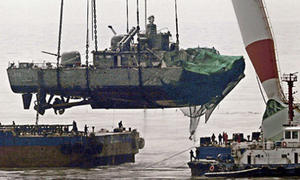Update: South Korean corvette was sunk by conventional torpedoes
On 26 March an explosion destroyed the South Korean corvette Cheonan, killing 46 of its crews of 104; the North Koreans were suspected to be behind the attack, and stories circulated about a midget submarine and “human torpedoes”; an examination of the ship wreckage leads South Korean naval investigators to conclude that it was destroyed by a conventional torpedo of advanced design — and that North Korea was indeed behind the attack; there is an outside possibility that the corvette ran into an old sea mine left floating in the water since the Korean War

Recovery of the stern of the Cheonan // Source: guardian.co.uk
Last Thursday we wrote about the sinking of 1,220-ton South Korean corvette Cheonan, which sank on 26 March with the loss of 46 of its 104 crew. We cited speculations by South Korean and Japanese intelligence sources which suggested that the attack was launched by the North Korean Navy using a midget submarine filled with explosives, or even a dozen or so special forces soldiers who became “human torpedoes” and who destroyed the South Korean ship in a suicide attack.
The story about the midget submarine and human torpedoes, while dramatic, now appears fanciful. The truth is more prosaic.
The New York Times’s Choe Sang-Hun reports from Seoul that the South Korean military is now ready to conclude — although not yet officially declare — that it was indeed the North Koreans who staged the attack (there is an outside possibility that the ship was destroyed by a sea mine left in the water since the 1950-53 Korean War), but that the damage to the South Korean ship was not caused by a midget submarine or a group of suicide bombers, but by a more conventional torpedo attack using a modern torpedo design.
Defense Minister Kim Tae-young was the first South Korean official publicly to blame a torpedo as a likely cause of the 26 March explosion that split the Cheanan in half, although South Korea has not yet blamed the North and Pyongyang has denied any involvement. “A bubble jet caused by a heavy torpedo is thought to be the most likely thing to be blamed, but various other possibilities are also under review,” Kim told reporters on Sunday.
A bubble jet effect occurs when a torpedo or mine detonates near or under a ship. The change of pressure creates a “bubble” underwater whose tremendous force as it expands and collapses can break the ship apart, according to defense ministry officials (see more below).
This theory appeared to be supported by Yoon Duk-yong, head of the government team of military and private investigators, who said on Sunday that the ship was likely broken in half “by a non-contact explosion, rather than a contact explosion.”
Yoon added that no soot, melting, or any explosion holes were found on the ship. These were often damage left when a ship suffered a direct hit, rather than an explosion at close range, he said. He did not clarify, though, what type of explosion — torpedo or mine —
